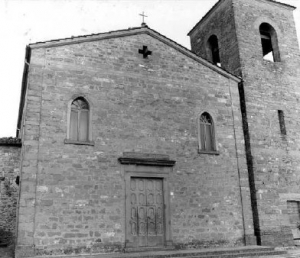
Information
Address:
Via Roma 17, 55030 Villa Collemandina (LU)
Foundation:
XII century
Telephone:
+39 0583 68281
District/Location:
Villa Collemandina
District:
Garfagnana


Documented as a subsidiary of the Fosciana Parish Church since the 12th century, this church underwent complete restoration following the devastating earthquake of 1920, whose epicentre was precisely at Villa Collemandina. It contains important sculptural and pictorial evidence of the Civitali studio.
Villa Collemandina
The church is mentioned in a document from 1168, from which it results as a subsidiary of the Fosciana Parish Church. It must have had a reasonable income given that its rector bought an expensive antiphonary from the Chapter of Lucca in 1246. There was small hospital attached to the church that results as already being restored in 1467 and already ruined and abandoned by the 17th century. In 1822 the church was linked to the new diocese of Massa and in 1836 it became a parish; it returned to being part of the diocese of Lucca in 1992. The building underwent a number of modifications up to the extension and reconstruction of the façade in the mid 19th century and the complete restoration needed after the disastrous earthquake of 1920. The bell tower was also completely rebuilt in 1926. Located within a group of buildings including a 13th century cloister, suggesting the original presence of a religious order, the church contains important evidence of the Civitali studio. The altarpiece, presently situated in the wall of the presbytery, was originally commissioned for the high altar, after this was consecrated in 1467. It consists of three wooden statues, a Madonna, a Saint Sisto and Saint Clemente, an alto-relievo of Dio Padre and a predella painted with the Stories of Saints Ansano, Rocco, Antonio abate and Sebastiano. This work, started by Masseo Civitali, nephew of Matteo, was finished by the brother Vincenzo in the 1520s. The hand of Vincenzo is clearly preponderant, as demonstrated by comparison with the statues they sculpted for the church of S. Pietro of Castiglione. Matteo’s son, Nicolao Civitali, is attributed with the marble altar-frontals at the sides of the high altar with an aedicule structure decorated by ornaments characteristic of the Civitali studio. One of these, originally intended as a shrine for the SS. Sacramento, was used in the 16th century to frame a papier-mâché statue of S. Margherita, patron of a Confraternity at the church from 1349. The other framed a Madonna of Loreto on an altar dedicated to the SS. Rosario commissioned by a parish devotee and preserved by the Company of the same name, founded in 1616. In the church there is also a Deposition by Luchi.
Scopri altre attrazioni vicino a Saints Sisto and Margherita
See allYou may also like..
See allFind more
0











